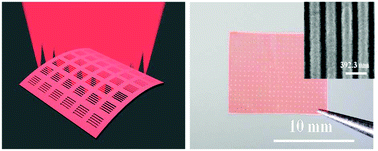A mechanically bendable and conformally attachable polymer membrane microlaser array enabled by digital interference lithography
Abstract
The progressive miniaturization and thinning of photonic devices would enable the realization of multi-functional photonic integrated circuits and expand the application frontier to novel fields including wearable and disposable electronics. Herein, we have demonstrated a mechanically bendable and conformally attachable polymer membrane microcavity laser array using digital interference lithography. The developed lithography system could distribute a number of subwavelength grating pixels with both high efficiency (1k pixels per second) and excellent versatility (ease of control in the pixel size, spacing, and grating periodicity) as the microcavity laser array, in which a pair of subwavelength gratings constitutes a distributed Bragg resonator microcavity via coherent interference, furnishes a vertically emitting microcavity laser array for convenient light coupling and utilization. The microlaser array polymer membrane presented a total thickness of only 30 μm with excellent performance stability and reliability against long time operation and harsh environmental conditions, which could be further reversibly stretched, repeatedly bendable and conformally attached onto rounded or irregular surfaces or biological tissues with no degradation in single-mode or low-threshold characteristics, paving a way for on-chip optical functionalization toward wearable electronics and outdoor environmental monitoring applications.



 Please wait while we load your content...
Please wait while we load your content...